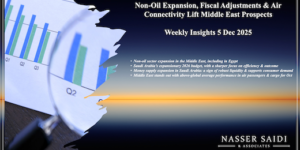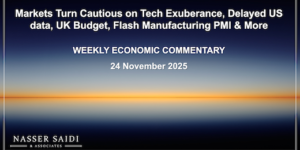Markets
Equities in the US rallied on encouraging earnings news (led by financials); dovish ECB and Brexit extension till Oct 31st supported European stock markets; Chinese data, largely pointing towards a stabilization, helped Asian markets: all this in the backdrop of trade rows clouding the global economy growth story. Fed funds futures indicate a 48% chance the Fed will cut rates in Jan 2020. In the region, most Middle East markets ended largely flat. The dollar weakened, while the Euro broke through a 3-week high during the week and the latest Brexit related developments had only a muted impact on the pound. Oil prices were up, settling above the USD 70 mark while gold prices inched lower.
Global Developments
US/Americas:
- US factory orders fell for the 4th time in 5 months, dropping by 0.5% mom in Feb, dragged down by weak orders for machinery, transportation equipment and computers and electronic products.
- Inflation in the US picked up, rising 0.4% mom in Mar (the biggest advance since Jan 2018, and up from Feb’s 0.2% gain), thanks to increases in the costs of food, gasoline and rents. Core inflation, excluding food and energy, nudged up by 0.1%. PPI advanced by 0.6% mom and 2.2% yoy in Mar, given the rise in gasoline costs.
- FOMC minutes confirmed that the US Fed remains “patient” on further rate hikes. Policymakers saw continued US economic growth, strong labour market and inflation near Fed’s objective as most likely outcome in next few years.
- The University of Michigan’s survey of consumer sentiment dropped to 96.9 for Apr, down from Mar’s 98.4.
- Initial jobless claims hit a near 50-year low, falling 8k to a seasonally adjusted 196k for the week ended Apr 6. The 4-week moving average fell 7k to 207k last week, the lowest level since early Dec 1969.
Europe:
- The ECB held interest rates unchanged at its latest meeting; Draghi, who warned of downside risks, also stated that the ECB stands ready to use “all available instruments” if the economic situation in the euro zone were to deteriorate further.
- Eurozone’s industrial production fell by 0.2% mom and 0.3% yoy in Feb (Jan: +1.9% mom), dragged down by Germany which posted a 0.4% dip in Feb (following Jan’s 0.2% decline).
- German trade surplus narrowed to EUR 17.9bn in Feb 2019 from EUR 18.3bn a year ago. Its seasonally adjusted exports fell by 1.3% in Feb, posting the largest decline in 12 months, while imports fell by 1.6%.
- The final reading of German CPI remained steady, clocking in at 0.4% mom and 1.3% yoy in Mar 2019.
- The UK economy grew by 0.3% in the three months to Feb, driven by the services sector. Production industries expanded by 0.2% in the three months to Feb – the first positive three-month growth since Oct 2018; manufacturing output was at its highest level since Apr 2008.
- UK’s industrial production expanded by 0.6% mom in Feb (Jan: 0.7%) while manufacturing rose 0.9% mom.
- The EU has offered the UK a “flexible extension” of the Article 50 negotiation period until Oct 31 in a bid to avoid a no-deal Brexit.
Asia Pacific:
- A slew of data from China: foreign reserves grew to a 7-month high of USD 3.099trn in Mar; inflation increased to a 5-month high, rising by 2.3% yoy in Mar (Feb: 1.5%), while producers price index rose by 0.4% yoy in Mar, thanks to higher oil and gas prices. China’s banks extended CNY 1.69trn of new loans in Mar while M2 grew by 8.6% yoy to CNY 188.94trn at end-Mar.
- China’s exports rebounded in Mar, rising by 14.2% yoy while imports shrank for the 4th consecutive month (-7.6% yoy), thereby bringing the trade balance to a surplus USD 32.64bn. Chinese-US trade is down 11% this year, with China’s Mar trade surplus with US at USD 20.5bn.
- Japan’s core machinery orders dropped by 5.5% yoy in Feb, after a 2.9% decline in Jan. Machinery orders grew by 1.8% mom in Mar, reversing the 5.4% fall from the month before.
- Japan’s current account surplus widened by 25.3% yoy to JPY 2.68trn (USD 24bn), supported by a goods trade surplus of JPY 489.2bn.
- Singapore’s GDP growth slowed to a decade low of 1.3% yoy in Q1 (Q4: 1.9%), given the -1.9% contraction in the manufacturing sector.
- Retail sales in Singapore posted a 10% fall in Feb, following Jan’s +7.6% rise, largely due to the Chinese New Year season. Food retailers saw the biggest plunge in sales: by 24.8%.
Bottom line: The IMF issued its latest World Economic Outlook, lowering global growth forecast (for the 3rd time in 6 months) to 3.3% this year – the weakest annual growth since 2009 – before improving to 3.6% in 2020. Dragged down by uncertainties surrounding Brexit and the US-China (and global) trade wars, the IMF also highlighted downside risks from tightening financing conditions, given a backdrop of large private and public sector debt. If US’s Mnuchin is to be believed, the China-US trade deal is nearing “final round” with US expressing its willingness to face repercussions from China in case it fails to comply. Concerns are rising from US trade tensions with Europe (EU is targeting USD 12bn of US goods in the Boeing subsidies dispute) while Japan hopes to wrap up a trade agreement with the US “very quickly” as negotiations begin Monday (Apr 15).
Regional Developments
- Bahrainis in Bahrain’s financial sector account for 65.6% of the total workforce (14,148 jobs); Bahraini women in the sector increased by 2.2% yoy to 3621 in 2018, accounting for 39% of the Bahraini workforce.
- Amendments to the 2015 Commercial Law and the 2001 Companies Law in Bahrain, which were issued in Dec through a royal decree, were approved. This aims to combat tax evasion, money laundering and terror funding, and thereby support the move of the country from the “dangerous” category to “safe”.
- Egypt’s PMI edged up to 49.9 in Mar – above 2018’s average of 49.5 and from Feb’s 48.2 – thanks to an improvement in output and new domestic orders. Overall input prices hit a record low at 50.8 in Mar from 53.6 the month before.
- Budget deficit in Egypt declined to EGP 259.7bn or 4.9% of GDP in Jul 2018-Feb 2019, after revenues increased by 23% and expenditures by 14.8%.
- Egypt’s inflation eased to 14.2% in Mar (Feb: 14.4%), after food supply issues were sorted and food and beverage prices were down to 1.5% mom from 3.5% mom in Feb. Separately, Egypt’s supply ministry disclosed that it plans to build a 5-6 months store of strategic commodity reserves (from 3 months previously).
- Egypt plans to launch three investment areas and five free zones this year.
- Egypt’s government purchased electricity worth EGP 400mn (USD 23mn) from the private sector until Mar 2019: 32 solar energy companies with a capacity of 1,432MW, and investments worth USD 2bn are implementing the projects with an aim to be connected to the national grid by end of next Dec.
- The Ministry of Housing in Egypt plans to establish over 1.1mn residential units over the next 5 years.
- Iraq plans to increase output from its Baiji oil refinery to 140k barrels per day (bpd) by end of this year, up from the current 45k bpd output.
- Iraq and Iran have reached an agreement to develop the Naft Shahr and Khorramshahr oil fields: Iraq imports roughly 1.5bn standard cubic feet of gas per day from Iran via pipelines in the south and east of the country.
- According to Jordan’s prime minister, though the country accounts for only 3% of the region’s population, it is home to 23% of entrepreneurs in the region.
- Kuwait’s Customs revenues increased by 12% yoy to KWD 367mn (USD 1.2bn) during the fiscal year 2018-2019, largely due to the recent plans like automated customs systems and facilitating clearance of customs data
- Fitch affirmed Kuwait’s long-term foreign-currency Issuer Default Rating(IDR) at ‘AA’ with a stable outlook, citing key strengths of exceptionally strong fiscal and external metrics and one of the lowest fiscal breakeven Brent oil prices among Fitch-rated oil exporters.
- Kuwait’s higher committee focusing on the demographic structure has recommended the implementation of a five-year cap on the stay of expatriates.
- Lebanon’s PM disclosed that preemptive measures were being taken to deal with the chronic budget deficit, reassuring the nation that the country’s financial and monetary situation was stable. Reducing the deficit-to-GDP ratio, which reached 11% in 2018, by 1 ppt every year over five years was one of the key pledges made at the CEDRE conference.
- Lebanon’s central bank governor unveiled a USD 1bn package of new subsidized loans– with USD 500mn allocated for the productive sectors in dollars, USD 100mn in loans for non-Lebanese residents, and USD 220mn for housing loans in Lebanese pounds.
- Lebanon’s cabinet endorsed the new electricity plan aiming to reform the sector; it was also agreed to renew Law 288, dated 2014, which empowers the Cabinet to grant temporary permits and licenses to produce electricity upon the proposal of the energy and finance ministers. However, a yet-to-be-resolved issue is the formation of the National Electricity Regulatory Authority.
- Qatar’s plan to increase its stake in Deutsche Bank has stalled, reported Reuters.
- Saudi Arabia’s PMI increased to 56.8 in Mar (Feb: 56.6), supported by a rise in new business (highest since Apr 2015), new orders (a near 4-year high of 65.5) and output (7-month high of 59.6). The employment sub-index however fell to 49.8, contracting for the first time in 5 years.
- The IMF maintained Saudi Arabia’s growth forecast for this year at 1.8%, forecasting a pickup to 2.1% next year.
- Saudi Aramco disclosed that it had raised USD 12bn from its debut international bond issue. The offering is expected to close on Apr 16.
- Saudi Arabia’s energy minister stated that there would beno change to the long-standing policy of trading oil in dollars. Separately, he also stated that there were no plans to deepen oil production cuts and that the OPEC+ meeting in May would be a “key” gathering.
- About SAR 430mn (USD 111.8mn) was deposited into the bank accounts of close to 284k job hunters in Saudi Arabia by the Human Resources Development fund.
- Saudi Arabia’s internal tourism spending touched SAR 121.5bn (USD 32.39bn) in 2018, with spending on domestic tourism trips at SAR 46.3bn. Inbound tourism spending grew 13.6% to SAR 12.5bn in Jan-Feb 2019. According to the World Travel and Tourism council, the nation’s travel and tourism sector is expected to contribute USD 70.9bn to the GDP this year.
- The double taxation avoidance agreement between Saudi Arabia and the UAE came into force in the beginning of this month. The agreement aims to strengthen the cooperation in tax matters and consolidate the financial, economic and investment partnership between the two countries.
- The GCC capital market issuance is likely to recover after a slow Q1 2019, led by Saudi Aramco and Saudi Telecom, according to S&P.
- The IMF, in its latest World Economic Outlook, expects GDP growth in the MENA to edge down to 1.3% in 2019 before posting a strong recovery to 3.2% in 2020.
UAE Focus
- PMI in the UAE increased to 55.7 in Mar, from the 28-month low of 53.4 in Feb, with both the output (63 from 59.3) and new orders (59 from 55) sub-indices rising. The employment sub-index rose to 50.3 (from Feb’s dismal 47.5 reading) while selling prices continued a 6-month contractionary streak.
- The IMF expects UAE to grow by 2.8% this year, and by 3.3% next year while inflation is expected to drop to 2.1% this year and next due to declines in rentals and property prices.
- Inflation in the UAE fell for the 3rd consecutive month, posting -2.53% yoy and -0.3% mom reading in Feb, as both food and transport costs plunged.
- Dubai’s non-oil economy expanded in Mar: the Dubai Economy Tracker increased to 57.6 – the highest since May 2018 – and up from Feb’s 55.8, led by the travel and tourism sector (posted a record high of 59.8).
- The UAE attracted USD 10.35bn in foreign direct investments in 2017, accounting for 36% of the total FDI inflows to the Arab countries, according to the Ministry of Economy.
- FDI into Dubai surged by 41% yoy to AED 38.5bn (USD 10.5bn) in 2018; US, India, Spain, China and the UK together accounted for 70% of the total.
- South Korea and UAE have renewed the USD 5.4bn currency swap deal for another three years (till Apr 2022). First signed in 2013, the deal had expired in Oct 2016.
- Data from the private sector can add almost AED 10bn to Dubai’s economy, according to the director-general of Smart Dubai. Currently, Majid Al Futtaim, Nakheel, and Property Finder are part of this private sector data project being carried out by Smart Dubai.
- Dubai moved into 9th position globally in a list of maritime capitals (moving up from 10thin 2017), according to the Leading Maritime Capitals report for 2019. (The report can be accessed at https://www.menon.no/leading-maritime-capitals-of-the-world-report-2019/?lang=en)
Media Review
Peaceful co-existence 2.0 by Dani Rodrik
https://www.project-syndicate.org/commentary/sino-american-peaceful-economic-coexistence-by-dani-rodrik-2019-04
Mario Draghi’s successor at the ECB has plenty to do
https://www.economist.com/finance-and-economics/2019/04/13/mario-draghis-successor-at-the-ecb-has-plenty-to-do
Brexit black hole: Divorce implosion, deal, or election?
https://uk.reuters.com/article/uk-britain-eu-scenarios/brexit-black-hole-divorce-implosion-deal-or-election-idUKKCN1RO1O5
https://www.project-syndicate.org/commentary/brexit-impossibility-triangle-by-emily-jones-and-calum-miller-2019-04
Global house-price index: The Economist
https://www.economist.com/graphic-detail/2019/03/11/global-house-price-index
Uber’s XL IPO
https://www.finimize.com/wp/news/ubers-xl-ipo/
https://www.reuters.com/article/us-uber-ipo/uber-unveils-ipo-with-warning-it-may-never-make-a-profit-idUSKCN1RN2SK
China-US Tensions, War with Iran Dominate Medium-Term GCC Risk Landscape
http://www.bondsloans.com/news/article/2099/china-us-tensions-war-with-iran-dominate-medi
Stumble in Saudi Aramco bonds highlights overbidding irritant
https://www.ft.com/content/57fe6a20-5bce-11e9-939a-341f5ada9d40
Powered by:









